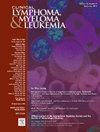Analyzing Two Decades of Leukemia Mortality in the U.S. (1999-2020)
IF 2.7
4区 医学
Q2 HEMATOLOGY
引用次数: 0
Abstract
Background
Leukemia is a hematologic malignancy with varying incidence and outcomes influenced by demographic and geographic factors. Understanding mortality trends and disparities is essential for guiding public health policy.
Objective
To analyze leukemia mortality trends in the U.S. from 1999 to 2020, focusing on age-adjusted mortality rates (AAMRs), disparities, and geographic patterns.
Methods
Data from the CDC WONDER database were analyzed, covering leukemia-related deaths (ICD-10 codes C91-C95). Age groups were stratified into < 45 and ≥ 45 years. Joinpoint regression models estimated annual percentage changes (APCs). Data were examined by demographics, census regions, and urbanization levels.
Results
AAMRs for individuals ≥ 45 years declined by an APC of −0.90% but increased slightly from 2018 to 2020. Males, non-Hispanic Whites, and rural populations exhibited higher AAMRs. Among individuals < 45 years old, AAMRs consistently declined with minimal disparities. Acute myeloid leukemia was predominant among older adults, while acute lymphoblastic leukemia affected younger populations.
Conclusion
Despite overall declines in leukemia mortality, persistent disparities across age, gender, and geographic regions highlight inequities in healthcare access. Strategic interventions are required to address these gaps and enhance leukemia care nationwide.
美国白血病死亡率二十年分析(1999-2020)。
背景:白血病是一种血液学恶性肿瘤,其发病率和预后受人口统计学和地理因素的影响。了解死亡率趋势和差异对于指导公共卫生政策至关重要。目的:分析1999年至2020年美国白血病死亡率趋势,重点关注年龄调整死亡率(AAMRs)、差异和地理模式。方法:分析来自CDC WONDER数据库的数据,包括与白血病相关的死亡(ICD-10代码C91-C95)。年龄分组分为< 45岁和≥45岁。接合点回归模型估计年百分比变化(APCs)。数据按人口统计、人口普查地区和城市化水平进行检查。结果:从2018年到2020年,≥45岁个体的AAMRs APC下降了-0.90%,但略有上升。男性、非西班牙裔白人和农村人口表现出较高的aamr。在< 45岁的个体中,aamr持续下降,差异很小。急性髓性白血病在老年人中占主导地位,而急性淋巴细胞白血病影响年轻人。结论:尽管白血病死亡率总体下降,但年龄、性别和地理区域之间的持续差异突出了医疗保健获取方面的不平等。需要采取战略性干预措施来解决这些差距,并在全国范围内加强白血病护理。
本文章由计算机程序翻译,如有差异,请以英文原文为准。
求助全文
约1分钟内获得全文
求助全文
来源期刊

Clinical Lymphoma, Myeloma & Leukemia
ONCOLOGY-HEMATOLOGY
CiteScore
2.70
自引率
3.70%
发文量
1606
审稿时长
26 days
期刊介绍:
Clinical Lymphoma, Myeloma & Leukemia is a peer-reviewed monthly journal that publishes original articles describing various aspects of clinical and translational research of lymphoma, myeloma and leukemia. Clinical Lymphoma, Myeloma & Leukemia is devoted to articles on detection, diagnosis, prevention, and treatment of lymphoma, myeloma, leukemia and related disorders including macroglobulinemia, amyloidosis, and plasma-cell dyscrasias. The main emphasis is on recent scientific developments in all areas related to lymphoma, myeloma and leukemia. Specific areas of interest include clinical research and mechanistic approaches; drug sensitivity and resistance; gene and antisense therapy; pathology, markers, and prognostic indicators; chemoprevention strategies; multimodality therapy; and integration of various approaches.
 求助内容:
求助内容: 应助结果提醒方式:
应助结果提醒方式:


